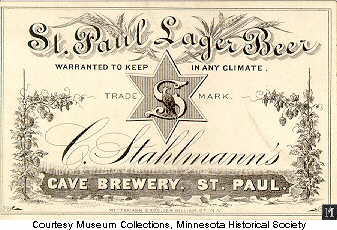Both my mom's and dad's families have roots in St. Paul, so I've spent a great deal of time there myself. As such, I too consider it an eminently likable city.
Given his avid interest in brewing, Sean's comment prompted me to recall that one of my great-great-great grandfathers (on my dad's side) was one Christopher Stahlmann, who opened the Stahlmann Cave Brewery in St. Paul on Fort Rd. (West 7th St.) and Oneida in 1855.

According to this article from the Master Brewers Association of the Americas:
THE FIRST BREWERY to make use of the land now occupied by Heilemann's was Christopher Stahlmann's Cave Brewery. Stahlmann's facility was officially opened on July 5, 1855, in what was then the western reaches of the city and a rural wilderness paved only by a wagon trail named Fort Road. What no doubt lured Stahlmann to this particular out-of-the-way spot was the existence of both cool natural springs and caves on the property. The caves, which still exist under West Seventh Street, were eventually excavated by Stahlmann (at a cost of $50,000) to reach three levels in depth and a mile in width. An 1883 business publication described the caverns as follows:
"A perfect labyrinth of rooms and cellars and under cellars three deep, reminding one of the catacombs of Rome, for none unacquainted with these subterranean vaults, without a guide, could grope their way through them and find their way out to daylight."
Christopher Stahlmann, the founder and developer of Cave Brewery, was described by Newsom as "a large man, slow in his movements, yet a man with a good deal of business tact and sagacity and very generally known throughout the city." He was born to an affluent family in Bavaria in 1829, but due to the bankruptcy of his father, he emigrated to America in 1846 with only "five dollars in his pocket!" After stays in Canada, Indiana, Cincinnati, and Iowa, Christopher and his Iowa bride, Katherine Paulas, moved to St. Paul, in 1855 "with just a few dollars."
From these "few dollars" Stahlmann created an enterprise that quickly became the largest brewery in Minnesota. According to available beer-production records for the years 1867-1879, Stahlmann was the number one beer-maker in the state. (He averaged more than 10,000 barrels of beer per year.) Although Stahlmann lost his number one position in the mid-1880s, his brewery continued to increase production, reaching a high of 40,000 barrels a year by 1884. Cave Brewery, according to an ad in an 1883 city directory, made "the finest quality lager beer" in "the most extensive brewing establishment in the state or the Northwest."
Unfortunately (for our family), all good things must come to an end:
In 1897, the once great Stahlmann Brewing Company went bankrupt and its last president, Charles J. Dorniden, had to sell the plant to a new enterprise, The St. Paul Brewing Company. The company existed only three years, for in 1900 the entire facility, including the beautiful stone mansion of Christopher Stahlmann at 855 West Seventh Street, was sold to the Jacob Schmidt Company (formerly the North Star Brewery).
The aforesaid article also has information about the Schmidt Brewing Company, one of the most famous names in Minnesota brewing history.
Why caves, you may ask?
Between the mid-1840s and 1870, German immigrants to the United States brought with them their traditional fondness for beer, which had not previously been of great importance in this country, where harder liquors were usually preferred -- something that has been called the “beer invasion.”
Ironically, this invasion was apparently facilitated not only by the burgeoning German population, but also by temperance agitation, which originally focused largely on “ardent spirits,” leading many Americans to choose the less potent beverage.
Prior to 1840, there were no breweries in America producing the German-style lager beer. Lager beer differed from the prevalent English and American beers, such as ale, in that the lager yeast fermented at the bottom of the vat, rather than the top, and the beer required lagering, or storage, for several months at lower temperatures. In the old days, lager beer could only be brewed during the winter months, when cellar temperatures were sufficiently low.
But in northern states, such as Minnesota, where natural ice was readily available, ice cakes could be harvested from nearby lakes and rivers in winter and stacked in caves, allowing brewing all year round to meet the growing demand.
The article from which the excerpt above was taken contains a first-hand account of a recent exploration of Stahlmann's Cellars — indeed, they still exist today! (Note: I originally found the article in PDF, with pictures, but for some reason now it doesn't open).
If that sort of thing interests you, check thou it out.



3 comments:
Interesting post on the Stahlman brewery cave. The links to that article were changed but it is still on my blog page http://hollow-hills.com/Blogs/index.php
along with several other brewery cave stories and locations under the UExploring Articles and Stories section.
GK
Hi John,
Great posting! I am doing family history research and have recently learned that my family lived in the area of the brewery. Do you know if the company's records are at the Minnesota Historical Society? I am curious if, perhaps, my ancestor may have worked at the brewery.
Also, thought I'd share a link I found that has the photos:
http://waybackmachine.org/web/20090419090326/http://hollow-hills.com:80/Blogs/wp-content/uploads/2007/01/SchmidtCaves.pdf
Tina,
Thanks for the link to the photos!
I'm embarrassed to say I've never visited the MHS, but I suspect they may have some of the brewery's records there.
The St. Paul Public Library may have some of them too.
Post a Comment